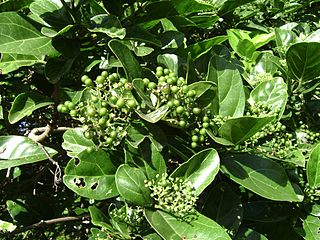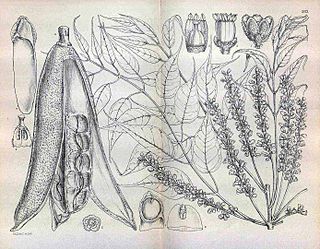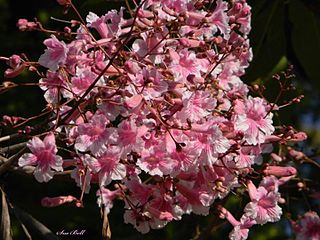
Pachypodium ambongense is a species of plant in the family Apocynaceae. It was first published as a species of the genus Pachypodium in 1924 by the botanist Henri Louis Poisson.
Pachypodium bicolor is a species of plant in the family Apocynaceae.

Vatica chinensis is a species of flowering tree in the family Dipterocarpaceae, found in South Asia.

Syringa reticulata, the Japanese tree lilac. is a species of flowering plant in the family Oleaceae native to eastern Asia, which is grown as an ornamental in Europe and North America.

Premna serratifolia is a small tree/shrub in the family Lamiaceae. It flowers and fruits between May and November. During flowering season, it attracts a large number of butterflies and bees. Synonyms of Premna serratifolia Linn. include P. corymbosa Merr., P. integrifolia L. and P. obtusifolia R. Br.).

Coccinia intermedia is a species of Coccinia which was first described in 2011 by Norbert Holstein.

Lecythis zabucajo, the sapucaia or paradise nut, is a large nut-producing tree occurring in the Guianas, Suriname, Venezuela, Ecuador, Honduras and Brazil, and which distribution range is much the same as that of the greater spear-nosed bat. Although not singling out Lecythis zabucajo, Jacques Huber noted in 1909 that fruit bats played the most important role in seed dispersal in Amazonian forests. The quality of its nuts led to the species' being introduced to numerous tropical countries, notably Trinidad, where it has flourished. The nuts are a valuable food resource and yield oil suitable for cooking and domestic use.
Acanthopale pubescens is a species of the genus Acanthopale of the family Acanthaceae. The species occurs in East and Southern Africa. Acanthopale pubescensis also known as Herayye in Ethiopia.

Omphalocarpum elatum Miers is a tall, tropical African tree belonging to the family Sapotaceae, remarkable for the large fruits growing directly from the trunk, and in many ways resembling the Lecythidaceae genus Napoleonaea. It is found in Equatorial Guinea, Sierra Leone, Ghana, the Central African Republic, Gabon, the Democratic Republic of the Congo, Nigeria, Liberia, Cameroon, Côte d’Ivoire and Angola in the south. The fruits are favoured by elephants, the only animals able to break through the hard shell. They do this by skewering the fruit with a tusk while using their trunk to brace it against the ground. Having passed through the elephant's digestive tract, seeds germinate more readily. Although not yet endangered, the tree's life cycle is tied to that of forest elephants, and may become threatened in regions where elephant populations are under pressure.

Euclea crispa, commonly known as the blue guarri, is an Afrotropical plant species of the family Ebenaceae. The hardy and evergreen plants may form a dense stand of shrubs, or grow to tree size. It is widespread and common in the interior regions of southern Africa, and occurs northward to the tropics. Though some are present near the South African south and east coasts, they generally occur at middle to high altitudes. It is readily recognizable from its much-branched structure and dull bluish foliage colour. Those bearing lanceolate leaves may however resemble the Wild olive, another common species of the interior plateaus.

Entandrophragma caudatum, or mountain mahogany, is a large Southern African tree belonging to the mahogany family and found in eastern and north eastern South Africa, Eswatini, Botswana, Angola, the Caprivi Strip region of Namibia, Zimbabwe, Zambia and Malawi. Kew currently recognises 12 other species of Entandrophragma, all with a tropical and sub-tropical African distribution.

Stereospermum kunthianum is an African deciduous shrub or small tree occurring in the Democratic Republic of Congo, Djibouti, Eritrea, Ethiopia, Kenya, Malawi, Senegal, Somalia, Sudan, Tanzania and Uganda. It is widespread across Africa to the Red Sea, and reaches as far south as Angola, Mozambique, Zambia and Zimbabwe. There are some 30 species with a Central African and Asian distribution.

Acacia burkittii is a species of wattle endemic to Western Australia, South Australia and western New South Wales, where it is found in arid zones, and is a perennial shrub in the family Fabaceae. Common names for it include Burkitt's wattle, fine leaf jam, gunderbluey, pin bush and sandhill wattle. It has also been introduced into India. Previously this species was referred to as Acacia acuminata subsp. burkittii, but is now considered to be a separate species. Grows in mallee, eucalypt and mulga woodland or shrubland, often on sandhills.

Combretum hereroense, commonly known as the russet bushwillow and the mouse-eared combretum, is a deciduous shrub or small tree that is found from eastern Africa to northern South Africa. Over its extensive range it is variable with respect to leaf shape, fruit size and indumentum.

Parkia filicoidea, or African locust bean, is a large, spreading flat-crowned tree to 30 metres tall, the bole of which may be narrowly buttressed to a height of about 3 metres, and up to 120 cm DBH. It occurs in wet evergreen or semi-deciduous forest, sometimes on forest fringes, riverbanks and lakes, termite mounds, at elevations up to 1000 metres from Côte d’Ivoire, east to Sudan and Somalia, Uganda, Kenya, Malawi and south to Angola, Zambia, Zimbabwe and Mozambique. Bark on trunk scaly or smooth, grey to yellow-brown, branchlets glabrous to puberulous.

Fockea multiflora, or python vine/creeper, is a large succulent liane, growing to some 15m in length and up to 60 cm in diameter, and found in Kenya, Tanzania, Malawi, Zambia, Zimbabwe, Mozambique, Botswana, Namibia and Angola. Fockea comprises 6 species, all occurring south of the equator in Africa.

Pajanelia, sometimes known in English as tender wild jack or pajanelia, in Malayalam as azhantha or pajneli, in Kannada as alangi and in Tamil as aranthal, is a monotypic genus of evergreen or briefly deciduous flowering tree in the family Bignoniaceae which contains a single species, Pajanelia longifolia.

Ficus amplissima, also known as the Indian Bat tree, Indian Bat fig, Pimpri, Pipri (Piparee), Pipali or Bilibasari mara is a tree species of flowering plants that belongs to Moraceae, the fig or mulberry family. It is native to Central and southern Peninsular India, Sri Lanka and Maldives, having a significant distribution throughout Western Ghats of India. It is most commonly planted to provide shade in coffee plantations due to its dense and wide foliage. The ripened figs attract many birds, especially during the spring.

Protea madiensis, commonly known as the tall woodland sugarbush, is a flowering shrub which belongs to the genus Protea. It is native to the montane grasslands of Sub-Saharan Africa.
Tennantia is a monotypic genus of flowering plants belonging to the family Rubiaceae. It only contains one known species, Tennantia sennii(Chiov.) Verdc. & Bridson



















